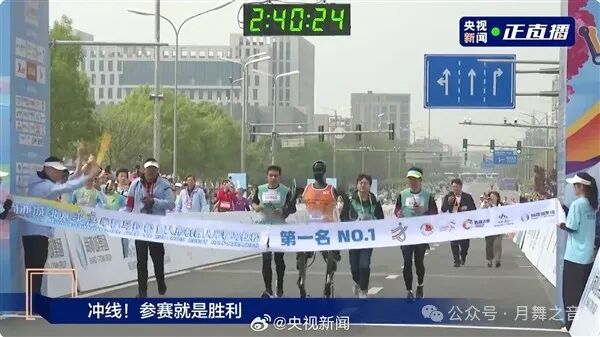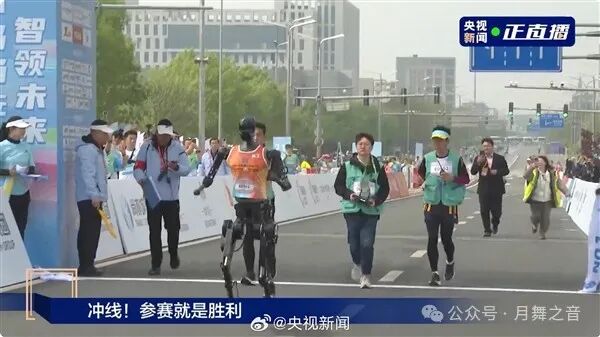On April 19, 2025, at 10:21 AM, a new chapter in human technological history was written in Beijing’s Yizhuang Economic and Technological Development Zone — the world’s first half marathon event specifically designed for humanoid robots. The Tiangong robot, standing at 1.63 meters tall, crossed the finish line first with an astonishing time of 36 minutes and 54 seconds, its agile strides tracing a silver trajectory under the spring sunshine. This unprecedented event brought together 21 top robotic teams and 12,000 human runners, where carbon-based life forms competed against silicon-based life forms on the same track. The Tiangong robot maintained a stable running frequency of 1.92 meters per second, bringing the concept of “embodied intelligence” from the laboratory into public view.

As the third-generation general platform developed by the Beijing Humanoid Robot Innovation Center, the victory of the Tiangong robot was no coincidence. Its 550 TOPS computing power chip set constructs a real-time motion decision-making system, processing over 200 sets of environmental data every millisecond. The six-dimensional force sensor array can perceive ground reaction forces at the level of 0.1 Newtons, combined with a gait algorithm developed based on reinforcement learning, achieving a 97% energy conversion efficiency on asphalt surfaces. Notably, this performance represents a 300% improvement in endurance compared to the robot’s first public demonstration in November 2024, when it could only complete a 5-kilometer run at a speed of 6 kilometers per hour.
During the 21.0975-kilometer race, Tiangong demonstrated astonishing environmental adaptability. Its head-mounted 3D visual sensor scans the track terrain at a frequency of 60Hz, while the tactile film on its feet monitors pressure distribution in real-time. The Inertial Measurement Unit (IMU) maintains dynamic balance like the human vestibular system. When passing the supply station, the robot’s multimodal perception system can automatically identify the cone array, and its path planning algorithm completes obstacle avoidance decisions within 0.3 seconds. This technological breakthrough stems from a significant upgrade in February 2025, when the development team improved the tendon-driven structure, successfully challenging the continuous climbing task of 134 outdoor steps.

Within its 43-kilogram lightweight body lies China’s groundbreaking achievements in bionic robotics. The Tiangong’s hydraulic servo system employs a bionic muscle bundle design, with 12 active degrees of freedom that make its gait more closely resemble human biomechanical characteristics. Its energy system is particularly impressive: the solid-state battery pack consumed only 2.1 degrees of electricity throughout the race, equivalent to an energy consumption of less than 100 watt-hours per kilometer. This energy efficiency even surpasses that of some human professional athletes’ metabolic efficiency. The event’s technical committee revealed that the robot autonomously activated a “sprint mode” in the last three kilometers, increasing its step frequency from 90 steps per minute to 110 steps, indicating that the control algorithm has developed a rudimentary form of autonomy.
The unique scoring system of this event showcases a dual concern for technology and humanity. In addition to traditional rankings, the organizing committee established the Best Gait Award, requiring robots to navigate complex terrains including cobblestone paths and slopes; the Optimal Endurance Award assesses the failure rate under continuous working conditions. Interestingly, when the human champion arrived with a time of 1 hour and 2 minutes, Tiangong had already completed the race 25 minutes earlier. However, the event director emphasized: “This is not about replacement but inspiration; the robot’s stable output provides a new training reference for human athletes.”

After winning, the Tiangong robot showcased even more possibilities: its dexterous hands can perform delicate operations such as opening bottled water and grasping trophies, thanks to breakthroughs in tactile feedback by the development team. The Beijing Humanoid Robot Innovation Center stated that this platform will be open to fields such as emergency rescue and high-risk operations. According to on-site technical demonstrations, the Tiangong can transport 20-kilogram supplies on a 40-degree slope or work continuously for 4 hours in a smoke-filled environment. This modular design concept is driving humanoid robots from laboratory demonstrations to real-world applications.
As the award podium lights illuminated the streamlined body of the Tiangong, this event transcended mere competition. It not only showcased China’s technological integration capabilities in robot motion control, environmental perception, and energy management but also heralded the dawn of large-scale applications for humanoid robots. As the event commentator stated: “Today, not only was the finishing time record broken, but also all imaginations about the boundaries of machine capabilities.” On the track in Yizhuang, we may be witnessing the birth of another “Deep Blue moment” — when machines exhibit human-like intelligence in the dynamic environment of the physical world, the transformation brought about by this breakthrough will far exceed the outcomes of a chess game.
Please open in the WeChat client